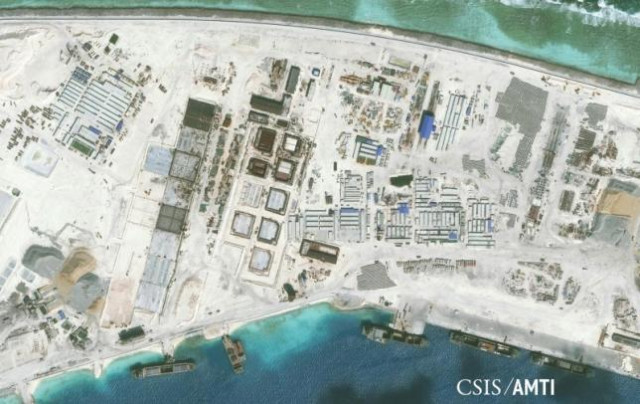China could build nuclear plants for South China Sea, paper says
China has rattled nerves with its military and construction activities on islands it occupies in South China Sea

The northwest side of Mischief Reef showing a 1,900 foot seawall and newly-constructed infrastructure including housing, an artificial turf parade grounds, cement plants, and docking facilities are shown in this Center for Strategic and International Studies (CSIS) Asia. PHOTO: REUTERS
China has rattled nerves with its military and construction activities on the islands it occupies in the South China Sea, including building runways, though Beijing says most of the construction is meant for civilian purposes, like lighthouses.
The Global Times, an influential tabloid published by the ruling Communist Party's official People's Daily, said the nuclear power platforms could "sail" to remote areas and provide a stable power supply.
China Shipbuilding Industry Corp, the company in charge of designing and building the platforms, is "pushing forward the work", said Liu Zhengguo, the head of its general office.
"The development of nuclear power platforms is a burgeoning trend," Liu told the paper. "The exact number of plants to be built by the company depends on the market demand." Demand is "pretty strong", he added, without elaborating.
Chinese Foreign Ministry spokesperson Hua Chunying played down the story as a media report, however. "I've not heard here of the relevant situation," Hua told a daily news briefing, without elaborating.
In January, two Chinese state-owned energy companies, China National Offshore Oil Corporation (CNOOC) and China General Nuclear Power Corporation (CGN), signed a strategic cooperation framework pact on offshore oil and nuclear power.
CGN has been developing a small modular nuclear reactor for maritime use, called the ACPR50S, to provide power for offshore oil and gas exploration and production. It expects to begin building a demonstration project in 2017.
Xu Dazhe, head of China's atomic safety commission, told reporters in January the floating platforms were in the planning stage and must undergo "strict and scientific demonstrations".
Chinese naval expert Li Jie told the Global Times the platforms could power lighthouses, defence facilities, airports and harbours in the South China Sea. "Normally we have to burn oil or coal for power," Li said.
It was important to develop a maritime nuclear power platform as changing weather and ocean conditions presented a challenge in transporting fuel to the distant Spratlys, he added.
China claims almost the entire South China Sea, believed to have huge deposits of oil and gas, and is building islands on reefs to bolster its claims. Brunei, Malaysia, the Philippines, Taiwan and Vietnam also have claims to parts of the waters, through which about $5 trillion in trade is shipped every year.


















COMMENTS
Comments are moderated and generally will be posted if they are on-topic and not abusive.
For more information, please see our Comments FAQ